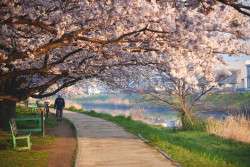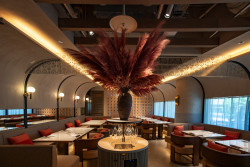
February 10, 2011
Nishinari
The largest slum in Japan is attracting a new breed of visitor: backpackers
By Metropolis
Originally published on metropolis.co.jp on February 2011

Photos by Manami Okazaki
 When Japanese people refer to a neighborhood as being “ghetto,” they usually just mean it isn’t as chic as Omotesando. However, the Nishinari district in southern Osaka, which holds the inglorious title of Japan’s biggest slum, is really quite impressive in its squalor.
When Japanese people refer to a neighborhood as being “ghetto,” they usually just mean it isn’t as chic as Omotesando. However, the Nishinari district in southern Osaka, which holds the inglorious title of Japan’s biggest slum, is really quite impressive in its squalor.
Getting off the train, you’ll immediately notice the homeless men and drunks. Things grow increasingly dour the closer you get to the area known as Kamagasaki, which has the highest concentration of homeless people in Japan. During the postwar boom, laborers flocked here from all over the country to work on construction projects such as the Expo 70. Many never left.
Nishinari is still home to an estimated 25,000 day laborers, of whom some 1,300 are now homeless, victims of a stale economy and lack of construction jobs, especially for aging workers. Most live in flophouses (of which there are many), and those who can’t afford a ¥1,000 room sleep in the park or on the street. In winter, hundreds huddle together in an effort to keep warm.
The atmosphere of the neighborhood verges on the post-apocalyptic, and a smell of burning tires hangs in the air. Every morning a thieves market is set up, selling anything from VCR remote controls (minus the VCRs) to single shoes and piles of somen noodles, stolen from god-knows-where. Yakuza groups work out of offices that are instantly recognizable by the shiny cars parked outside, while dealers peddle their products openly on the streets.
 Not for nothing has the area come to be seen as an anarchic zone by the general public—a reputation that wasn’t helped by the widely reported riots of 2008. Nishinari has provided a haven to fugitives on the lam, including Tatsuya Ichihashi, the suspected killer of Lindsay Ann Hawker, and Fusako Shigenobu, founder of the now-disbanded Japanese Red Army.
Not for nothing has the area come to be seen as an anarchic zone by the general public—a reputation that wasn’t helped by the widely reported riots of 2008. Nishinari has provided a haven to fugitives on the lam, including Tatsuya Ichihashi, the suspected killer of Lindsay Ann Hawker, and Fusako Shigenobu, founder of the now-disbanded Japanese Red Army.
However, things might slowly be changing thanks to the influx of an altogether different group of people. Many of the 120-odd flophouses in Nishinari are being converted into hostels, and the neighborhood now sees about 70,000 overseas travelers a year. Some have even gone so far as to describe it as the “Khao San Road of Osaka,” after the popular backpackers’ strip in Bangkok.
I stayed at Toyo Guest House, which is typical of the converted doya in the area. Most of the tatami rooms are tiny—less than 5m2—but come with an air conditioner, TV and futon. The toilets and showers are shared, and wouldn’t look out of place in a penitentiary, but at ¥1,700 a room it’s certainly cheap, and there’s a sento you can use for free at one of the other hostels around the corner.
The train fare to Kyoto is just ¥620 and, as manager Mr. Takeshita points out, “you won’t find lodging this cheap there.” “Since five years ago, we’ve been getting a lot of travelers from the USA and Europe, and lately other parts of Asia, too,” he says. “It’s become really popular because of the internet.”
 Takeshita recommends that guests check out Jan Jan Yokocho, an old-school street of eateries, as well as the Tsutenkaku area and Denden Town, Osaka’s electronics district. “Just don’t go here,” he says, marking a box on the map where the Kamagasaki district is located. “And here is the chemist’s road,” he adds euphemistically.
Takeshita recommends that guests check out Jan Jan Yokocho, an old-school street of eateries, as well as the Tsutenkaku area and Denden Town, Osaka’s electronics district. “Just don’t go here,” he says, marking a box on the map where the Kamagasaki district is located. “And here is the chemist’s road,” he adds euphemistically.
Convenient location aside, Nishinari does have a certain charm. The locals are friendly—although there aren’t many women, or people under 40—and there’s an unashamedly blue-collar vibe, with a comic theater, old-school shoji and go houses, cheap kushi katsu and suppon eateries, and even the odd ¥30 drink vending machine.
The illicit atmosphere attracts oddball characters at all hours of the day, including a sizeable contingent of transvestites. Nishinari is also home to Tobita, Osaka’s oldest red light district, where girls operate out of traditional houses with Amsterdam-esque windows, and the kitschy Shinsekai. The latter was constructed in 1912, with its northern half modeled on Paris and the lower half on Coney Island. Suffice to say that it now has a lot more in common with the latter.
Travel Tips
Nishinari can be accessed via Shin-Imamiya station (Osaka Loop line) or Dobutsuen-mae (Midosuji line). There are numerous hostels in the area, and prices range from ¥1,500 to ¥2,300 for the renovated establishments. If you want the bare minimum for a bare minimum price, Toyo Hotel is a good bet (www.hotel-toyo.jp). Be sure to visit Spa World, a “super sento” with an addictively kitsch range of themed bath areas. The Kamagasaki area is unsafe and best avoided.







